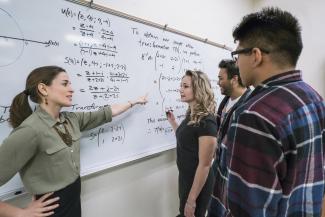
Do the preparation task first. Then listen to the audio and do the exercises.
Preparation
Transcript
Professor: OK, before we continue, does anybody have a question? Oh, lots of questions, I see. OK, we'll go one at a time. Yes?
Student: Thank you. You talked about Fibonacci numbers in the lecture. Sorry, I don't understand. Can you explain?
Professor: Of course. What do you want to know?
Student: OK … I hope this isn't a silly question, but what does Fibonacci actually mean?
Professor: No question is ever silly – it's always good to ask. OK, it's the name of a person. Fibonacci was a European mathematician in the Middle Ages.
Student: Ah, OK. Thanks. So, we know he was a person, but what are the Fibonacci numbers? I don't get it.
Professor: The Fibonacci numbers are a sequence of numbers. They go 1, 1, 2, 3, 5, 8 and so on. Do you see the sequence? Do you see how it works?
Student: I'm not sure.
Professor: OK. This is how it works. The first number is 1, then 1 again, then 2. The third number is the first number plus the second number. The fourth number is the second number plus the third number: 1 plus 2 is 3. The fifth number is the third number, 2, plus the fourth number, 3. So the fifth number in a Fibonacci sequence is 5.
Student: Ah! I think I understand now. But what about their importance? You said these were very important.
Professor: Yes, let me explain. This sequence of numbers is important because we see it in many things. Fibonacci numbers are common in geometry, they are common in nature, for example in plants. We see the sequence everywhere.
Student: Could you give us some more examples?
Professor: OK ... well, we don't have time right now but I can bring more examples in for next class, OK?




Fibonacci is awosome mathematicion all times, and ı have been hearting our teacher, ı remembered again thought B.C
The last lecture I attended was about the dangerousness of the silica inconstruction materials as marble. It was very interesting and the engineer that told about it was a very good communicator. I enjoy it and it was very useful for my diary work. I am a safety and healthy engineer.
Congratulations to British Council and I am sorry if I have mistakes...I am learning and I am not a young person...
The last lecture i attended it was about the genetic and the professor explain it clearly, i was enjoyed very much.
The last lecture I went was about the sacrify of Jesus to save us. the professor's explanition was cleary
Hello everyone, my name is Muhammad Najib Al Baihaqi, im a student from Tanjungpura University. The conversation between the professor and the student provides a helpful explanation of Fibonacci numbers. As a student, I appreciate how the professor made sure to explain the sequence clearly adding the two previous numbers to get the next one. It was great to see the professor encourage questions and patiently break it down step by step.
What stood out to me was learning that Fibonacci numbers are found in nature and geometry, which made me realize how math connects to the real world. I'm looking forward to hearing more examples in the next class. Overall, the professor’s approach made a difficult concept much easier to understand!
What was the last lecture you went to about? Did the professor explain it clearly?
The last lecture I attended was a Phrase Structure class. We learned about the phrase "How long does it take...." The lecturer explained the material in great detail so that I could understand it.
Hii Everyone ! My name is rashel galatia and i'm a students from the university of Tanjungpura . To be honestly , i can't speak english very well but, My Lecturer Introduced to me that there is a website called "BRITISH COUNCIL" that can help me to improve my listening and speaking . from there, i can get know how to improve our listening and speaking . until today, i'm so glad that i can improve my listening through this website . it is really helpful and i'm happy with it ! Thanks a lot, BRITISH COUNCIL .
hello everyone, I am Nizam, a student at Tanjungpura University, Pontianak. Honestly, I am very embarrassed about my English. then I tried to figure out how to fix it. and a lecturer at my university introduced BRITIS COUNSIL LearnEnglish. I really like it and find it helpful to improve my English. That's all from me, thank you
Honestly, congratulations. This exercise is very useful, because it is like the real life. In addition, it is very exemplary when the teacher said: "No question is a silly question". I am a Math teacher too and I teach to my students to ask any question no matter what. The important thing is to solve their doubt.
What was the last lecture you went to about? Did the professor explain it clearly?
The last lecture I went was abaout religion . Professor didnt explain it clearly. I think he need to improve his teaching skills and also need to learn how to creative interactive content for lectures. So I stopped joining his lesson becouse ıt was realy boring and it was taking a long